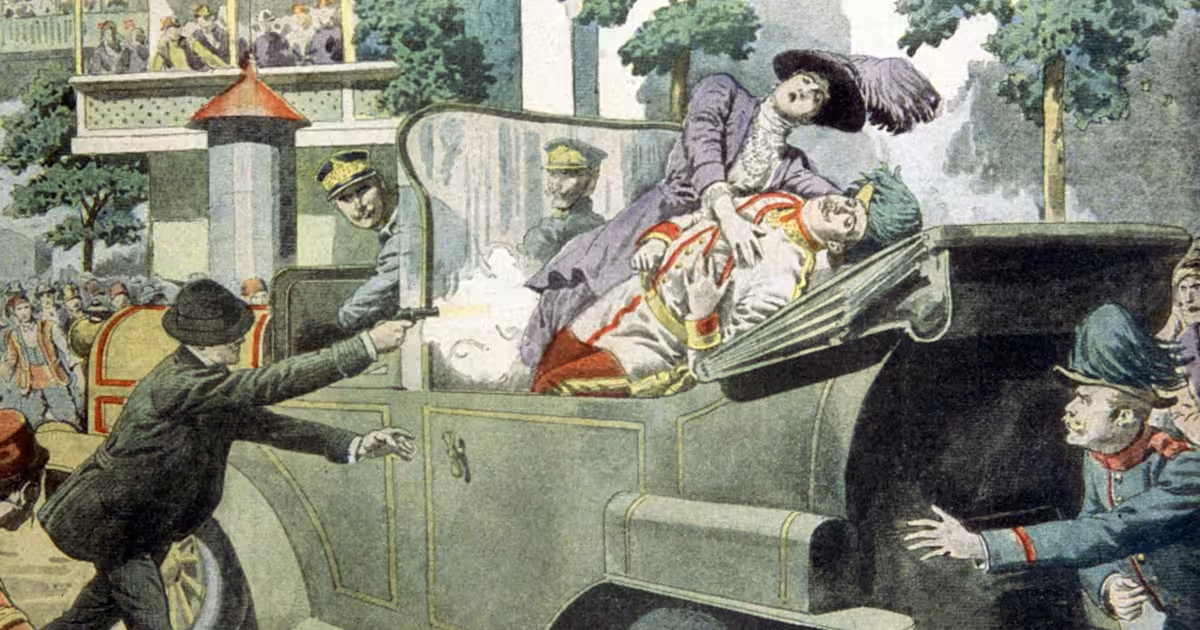
The History of the Assassination of Archduke Franz Ferdinand and Its Impact
Introduction: The Spark that Ignited a World War
The assassination of Archduke Franz Ferdinand, heir presumptive to the Austro-Hungarian throne, on June 28, 1914, in Sarajevo, Bosnia, stands as one of history’s most pivotal events. This seemingly singular act of violence didn’t merely shake the foundations of Europe; it triggered a chain reaction that engulfed the world in the catastrophic conflict of World War I. While the Archduke’s visit to Sarajevo – ostensibly to inspect military maneuvers and reinforce Austria-Hungary’s authority over the recently annexed Bosnia and Herzegovina – was intended to project strength, it tragically became a catalyst for unprecedented global devastation. This essay will delve deep into the intricate circumstances surrounding the assassination, examining the life of Franz Ferdinand, the motivations of his assassins, the immediate aftermath, and the profoundly lasting impact this event had on the course of the 20th century and beyond.
The Life and Political Significance of Archduke Franz Ferdinand
Franz Ferdinand Karl Ludwig Joseph Maria of Habsburg-Lorraine, born December 18, 1863, in Graz, Austria, was a man whose life, though ultimately cut short, played a significant role in shaping the destiny of the Austro-Hungarian Empire. As a member of the powerful Habsburg dynasty, he occupied a position of immense power and influence. His military career was distinguished, reflecting the Empire’s deeply entrenched militaristic culture. Beyond his military achievements, Franz Ferdinand held strong conservative and nationalist viewpoints, deeply invested in the preservation and strengthening of the multi-ethnic empire.
However, Franz Ferdinand was not simply a staunch conservative. He was acutely aware of the internal fragility of the Austro-Hungarian Empire, recognizing the simmering tensions and nationalist aspirations of its diverse ethnic groups. The empire, a patchwork of nationalities – Hungarians, Germans, Czechs, Slovaks, Poles, Serbs, Croats, Slovenes, Romanians, and others – was riddled with internal conflicts, making it a powder keg waiting for a spark. His marriage to Sophie Chotek, Countess of Hohenberg, in 1900, was considered a controversial morganatic marriage, highlighting his defiance of tradition and potentially revealing a progressive streak, though his overall political stance remained largely conservative. They had three children together, fueling speculation that he planned to reform the succession laws to secure their future.
Franz Ferdinand’s vision for the future of Austria-Hungary was complex and multifaceted. While he championed the maintenance of the Empire’s unity and strength, his approach differed from the rigid, inflexible policies of the existing establishment. He advocated for a more centralized, federalized system, where the diverse ethnic groups within the empire would have a greater degree of autonomy while remaining under the umbrella of the Habsburg monarchy. This so-called Trialism plan, proposing to elevate Bohemia to a third equal partner alongside Austria and Hungary, aimed to address the growing discontent within the empire. However, this vision was met with resistance from both Hungarian and Austrian nationalists, who feared losing power and influence. His reforms, though intended to strengthen the Empire, were ultimately perceived by some as undermining the existing power structure and potentially paving the way for its eventual demise. His assassination prevented the potential implementation of these reforms, leaving the Empire’s future uncertain and ultimately contributing to its collapse.
The Black Hand: A Nest of Serbian Nationalism and Violent Extremism
The assassination of Archduke Franz Ferdinand was not a spontaneous act of violence; it was the culmination of a meticulously planned operation orchestrated by the Black Hand (Crna Ruka), a secret Serbian nationalist organization. Officially known as the Union or Death (Ujedinjenje ili Smrt), the Black Hand was a clandestine group operating within the shadows, committed to achieving its nationalist goals through any means necessary, including violence and terrorism.
The group’s primary objective was the creation of a Greater Serbia, encompassing all territories inhabited by ethnic Serbs, including Bosnia and Herzegovina, then under Austro-Hungarian rule. This ambition clashed directly with the interests of Austria-Hungary, which viewed the region as vital to its own strategic and economic interests. The annexation of Bosnia and Herzegovina in 1908 had already heightened tensions between Austria-Hungary and Serbia, fueling Serbian nationalist resentment. The Black Hand saw the assassination of Franz Ferdinand as a strategic act, believing that it would trigger a conflict that would lead to the unification of Serbian territories under a single banner.
The intricate plot involved numerous individuals, each with specific roles to play. The assassination attempt was led by Danilo Ilić, a Bosnian Serb officer connected to the Black Hand’s leadership. Several young assassins were recruited and trained, including Gavrilo Princip, the man who ultimately fired the fatal shots. The choice of Sarajevo as the location for the assassination was significant, given its symbolic importance as a city with a sizable Serb population under Austro-Hungarian rule. The plan involved multiple attempts to assassinate the Archduke along his motorcade route, showcasing the group’s meticulous planning and determination.
The Black Hand’s organization and methodology, characterized by secrecy, conspiracy, and willingness to engage in extreme violence, exemplified the volatile political climate of the early 20th century in the Balkans. The group’s actions, while radical, reflected the deep-seated frustration and desire for national unity among a significant segment of the Serbian population. Their methods, however, were unequivocally brutal, setting the stage for a wider conflict with devastating consequences.
The Assassination: A Sequence of Events and a Fatal Turn of Fate
The fateful day of June 28, 1914, began with the Archduke and his wife, Sophie, embarking on their ill-fated visit to Sarajevo. The motorcade proceeded through the city, its route lined with potential assassins affiliated with the Black Hand. The first assassination attempt occurred when Nedeljko Čabrinović, one of the conspirators, threw a hand grenade at the Archduke’s car. The grenade bounced off the vehicle, injuring several bystanders, but failing to harm Franz Ferdinand and Sophie.
Instead of proceeding directly to their intended destination, the driver, Leopold Loyka, made a crucial and fateful mistake, taking a wrong turn that unexpectedly led the motorcade back to the very spot where the grenade had been thrown. This unexpected detour brought the Archduke’s car to a halt in front of a café, placing him within striking distance of Gavrilo Princip. Seizing the opportunity, Princip stepped forward, drew his Browning semi-automatic pistol, and fired two shots, fatally wounding both Franz Ferdinand and Sophie.
The immediate aftermath was chaotic. The assassins were apprehended, though some managed to escape initially. The news of the Archduke’s death spread rapidly, sending shockwaves through Europe. The assassination, while initially appearing to be a localized act of violence, quickly escalated into a major international crisis. The event exposed the fragility of peace in Europe and the dangerous potential of unchecked nationalism and political extremism.
The International Reaction: An Ultimatum and the Descent into War
The assassination of Archduke Franz Ferdinand triggered a rapid escalation of tensions between Austria-Hungary and Serbia. Austria-Hungary, firmly believing that Serbia was directly responsible for the assassination, issued a harsh ultimatum to the Serbian government on July 23, 1914. The ultimatum contained demands that were virtually impossible for Serbia to fulfill entirely, essentially setting the stage for war.
The ultimatum demanded Serbia’s cooperation in suppressing anti-Austrian activities within its borders, granting Austrian officials access to Serbian territory for investigations, and punishing individuals implicated in the plot. While Serbia attempted to meet some of the demands, its inability to fully satisfy Austria-Hungary’s conditions led to Austria-Hungary declaring war on July 28, 1914. This single act ignited the tinderbox of Europe’s complex system of alliances, setting off a devastating chain reaction that brought the continent and much of the world to war.
Russia, a traditional ally of Serbia, immediately mobilized its forces in support of its Slavic neighbor, further escalating the tension. Germany, a powerful ally of Austria-Hungary, responded by declaring war on Russia on August 1, 1914, invoking its military alliance with Austria-Hungary. France, bound by a treaty to Russia, found itself at war with Germany and Austria-Hungary, adding to the growing conflict. Great Britain, initially hesitant to enter the war, eventually joined the Allies in August 1914, following Germany’s invasion of neutral Belgium.
The diplomatic maneuvering and rapid escalation of the conflict clearly demonstrated the perilous interconnectedness of Europe’s political systems and the devastating potential of aggressive nationalism. The complex web of alliances and the prevailing militaristic climate transformed what might have been a localized crisis into a global conflagration. The assassination, therefore, acted not merely as a trigger, but as a catalyst that exposed the underlying vulnerabilities and unresolved tensions within the European political landscape.
The Long Shadow of World War I and its Legacy
The assassination of Archduke Franz Ferdinand triggered World War I, a conflict that profoundly reshaped the geopolitical landscape and the very fabric of society. The war lasted from 1914 to 1918, resulting in unprecedented levels of death and destruction, shattering empires and redrawing the map of Europe. Millions perished, not only on the battlefields but also as a result of disease and famine in the war’s wake.
The war’s conclusion saw the collapse of the Austro-Hungarian, German, Ottoman, and Russian Empires, radically altering the political map of Europe and the Middle East. New nations emerged from the ashes of the old order, while existing countries underwent significant territorial changes. The Treaty of Versailles, intended to establish a lasting peace, imposed harsh penalties on Germany, including territorial losses and crippling reparations, which arguably contributed to the rise of extremism and the eventual outbreak of World War II.
The interwar period, characterized by political instability, economic hardship, and social unrest, offered little respite from the conflicts that had ravaged Europe. Attempts to establish lasting peace through international organizations such as the League of Nations proved ultimately unsuccessful in preventing the outbreak of another global war. The legacy of World War I, shaped by the unresolved tensions and bitter resentments generated by the conflict, cast a long shadow over the 20th century.
The Enduring Impact and Historical Significance
The assassination of Archduke Franz Ferdinand remains a crucial event in modern history. Its significance extends beyond the immediate outbreak of World War I. It serves as a stark reminder of the fragility of peace, the dangers of unchecked nationalism and political extremism, and the devastating consequences of unresolved conflicts.
Historians continue to analyze the event, dissecting its intricate details and exploring the diverse factors that contributed to the outbreak of World War I. The assassination provides a compelling case study for examining the interplay of national interests, alliances, and the role of individual actions in shaping the course of history. It highlights the importance of diplomacy, conflict resolution, and the need for international cooperation in preventing future catastrophes. The event’s legacy remains relevant, reminding us of the need for vigilance in preventing similar conflicts from arising.
The assassination was not simply a single act of violence; it was a catalyst that exposed the inherent flaws within the European political system and revealed the fragility of its carefully constructed balance of power. The assassination became a symbol of the failures of diplomacy, the rise of unchecked nationalism, and the devastating impact of these factors in ushering in an era of global conflict.
In conclusion, the assassination of Archduke Franz Ferdinand was a watershed moment, transforming the course of history and leaving an enduring legacy that continues to resonate in the 21st century. The intricate interplay of events that followed, the devastating consequences of World War I, and the enduring questions raised about the nature of nationalism, international relations, and the prevention of war ensure that the assassination remains a subject of intense historical scrutiny and ongoing relevance. The event continues to inform our understanding of the complexities of international relations and serves as a powerful reminder of the potential consequences of political violence and unresolved tensions.


